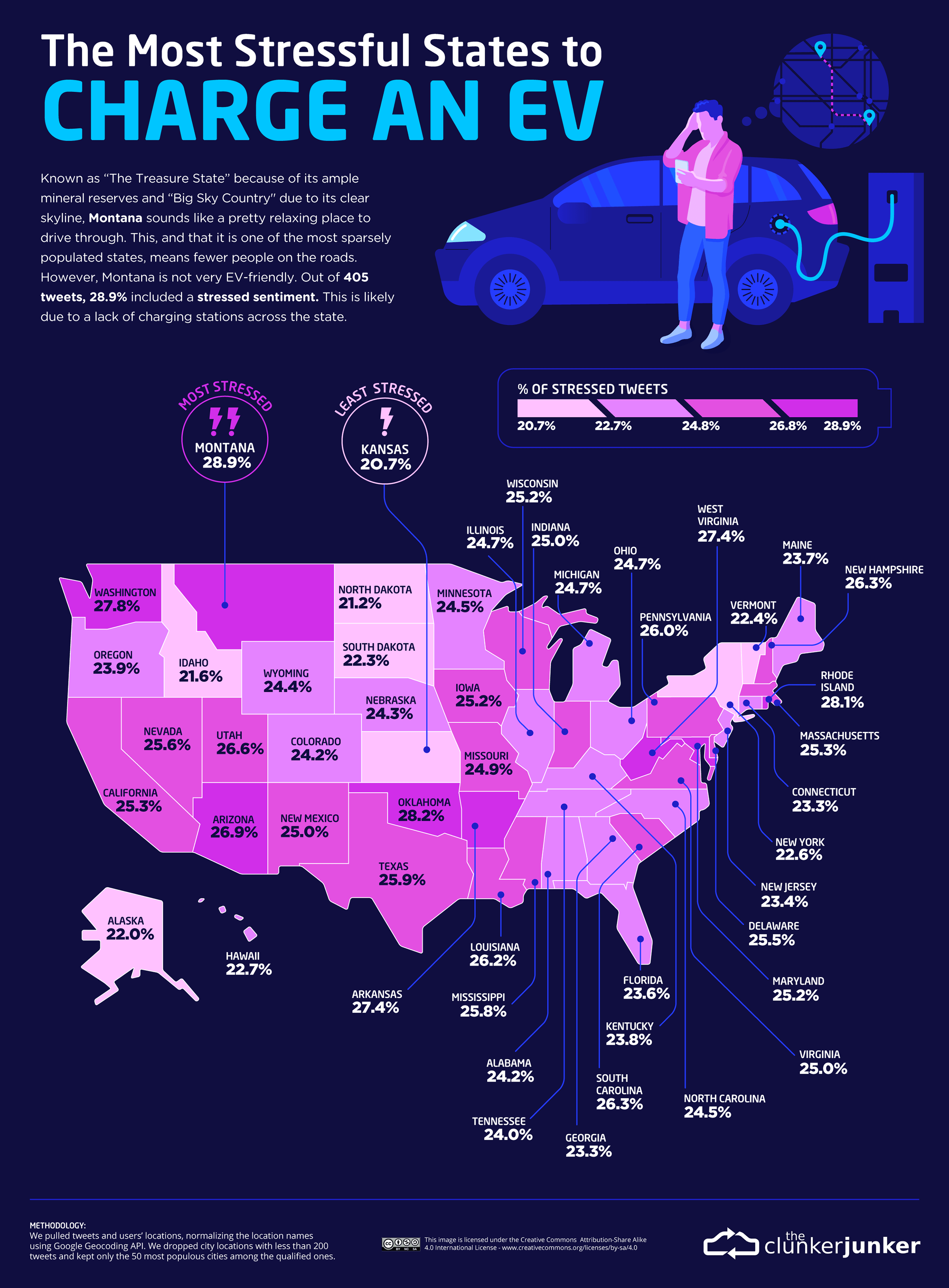
The Cities and States Where EV Charging Causes the Most Stress
September 06, 2022
Human ingenuity knows no bounds: as fast as we can design fabulous new solutions like the electric car, we can invent fabulous new neuroses – like “range anxiety.”
Range anxiety is the worry that your electric vehicle (EV) will run out of energy before you can reach a charging point (EVSE). It’s cell phone battery anxiety (technically known as nomophobia) with the added fear of getting stuck in the desert.
Power utilities around the U.S. are working to improve EVSE infrastructure (with the caveat that it’ll add to the rising energy bills of everybody – not just vehicle owners). But there’s another problem. Even if there’s an EVSE on your route, the time it takes to recharge remains inconvenient. It can be very tempting to risk running on empty to reach your destination on time. The U.S. boasts just 22,000 fast EVSEs (and 92,000 slow ones) compared to 150,000 roll-in, roll-out gas stations. The anxiety is real.
It helps to know in advance the likelihood of running into trouble. So, The Clunker Junker has identified the U.S. cities and states where EV range anxiety is most common.
What we did
he Clunker Junker gathered geotagged tweets featuring words and phrases related to charging an EV in every U.S. state and the 50 most populous cities. Then, we used an academic stress detection tool called TensiStrength to identify which ones showed signs of range anxiety.
Key Findings
- Montana is the state where EV charging causes the most stress, with 28.9% of related tweets showing signs of anxiety.
- Kansas has a stress rating of just 20.7%, making it the state with the least range anxiety.
- Oakland, CA, is the U.S. capital of range anxiety, with a 32.6% stress rating.
- Virginia Beach, VA, has the least range anxiety, with a stress rating of 20.3%.
One EV Charging Station Every 1100 sq. Miles Makes Montana Anxious
EV charging stress rates in the U.S. range from around 20-30% on both a city and state level. The state with the most range anxiety is Montana. At the start of 2022, the state had fewer than 3,000 fully electric or hybrid vehicles. Montana maintains one of the lowest EV uptake rates in the U.S. – perhaps because there are only 131 existing stations to serve America’s fourth-largest state by area.
However, EV registrations in Montana have doubled since 2019, and the state expects the number to rise to 130,000 by 2030. Some $43m of last year’s $1 Trillion Infrastructure Bill has been earmarked to counter range anxiety on the roads of Montana. This will help to level things out to Kansas’s anxiety levels – which are the lowest in any state, thanks to a total of nearly 460 EVSEs alongside the state’s 1,065 gas stations.
Oakland Apartment Owners Have Nowhere to Charge
Oakland, CA, is the most stressed big city in the U.S. when it comes to charging an EV. But with around 290 public charging spots available, anxiety may be confined to apartment-dwellers frustrated by the difficulties of charging overnight at home. “Level 2 charging should be required in all apartments,” tweets Brinda Thomas, a local owner with a PhD in Engineering and Public Policy. “I find it harder to charge an EV in Oakland than Fremont, bc of a lack of in-bldg charging. Most of the public charging options are in garages w 4-hr limits & require additional parking fees.”
The city with the least range anxiety is Virginia Beach, VA. The city has 63 charging stations right now. Still, itwill benefit from some of the $106.4 million allocated to the state to develop charging stations along designated Alternative Fuel Corridors, including on Interstate 64 between Virginia Beach and the border with West Virginia.
Life’s A Gas
The EV charging network has a long way to go before buying electric cars will feel ‘normal’ in the U.S. Today, neither the drivers nor EVSE providers feel comfortable with the situation. Motorists risk range anxiety or the worry of recharging in obscure parking lots, potentially after dark. Gas station and store owners, who are encouraged to install EVSEs, do not necessarily make a profit from their sales and are looking for reassurance that their efforts will be worthwhile. In our full data below, you will find exactly where the EV anxiety hits the hardest.
What are you going to do when your range fears are realized? When a cell phone runs short of battery, at least you can chat with other dwindling souls on the low-battery social network, Die With Me. Drivers who run out of juice can only hope there are fellow drivers to share a forlorn glance and perhaps signal for help. Battery swaps remain expensive and wasteful, while charge-sharing between cars requires network growth and availability. In the long term, help is on its way via the Infrastructure Bill. In the meantime, it’s best to keep enough battery on your cell phone, so you can at least tweet your range anxiety to the world.
METHODOLOGY & SOURCES
We pulled tweets using the following set of queries: ‘plugshare,’ ‘chargeway,’ ‘Tesla Supercharger,’ ‘EV charger,’ ‘EV charging,’ ‘Tesla charger,’ ‘Tesla charging,’ ‘electric charging station,’ and ‘supercharger.’
Then we pulled the users’ locations and normalized the location names using Google Geocoding API.
At the city level, we dropped locations with less than 200 tweets and kept only the 50 most populous cities among the qualified ones.
The data was collected in June 2022.

